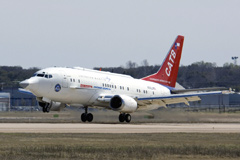
|
F-35 'CatBird' Avionics Test Bed
Transitions to Lockheed
|
|
|
3/2/2007 - FORT WORTH, TX -- The Cooperative Avionics Test Bed, a modified 737 designed to validate the F-35 Lightning II’sTM avionics suite, flew today from Mojave, Calif., to Lockheed Martin’s Fort Worth plant to prepare for airborne mission systems testing later this year. The Lightning II’s avionics package will be the most advanced, comprehensive and powerful of any fighter in the world. “The arrival in Fort Worth of the Cooperative Avionics Test Bed, or ‘CATBird,’ aircraft is a defining moment for the F-35TM program,” said Doug Pearson, Lockheed Martin vice president of the F-35 Integrated Test Force. “It is a visible symbol of the progress we have made as a team and moves us one step closer to delivering war-fighting capability to our customers.” The CATBird will integrate and validate the performance of all F-35 sensor systems before they are flown on the first Lightning II aircraft. “Today’s milestone initiates a phase of unprecedented integrated avionics test capability,” said Eric Branyan, Lockheed Martin vice president of F-35 Mission Systems. “The rigorous testing performed on board the CATBird will ensure that mature functionality is delivered to the F-35 Lightning II." During the second-phase modifications in Fort Worth, the F-35 team will install test stations in the main cabin, and instrumentation to monitor and measure the in-flight performance of various installed sensors. Workers also will complete the installation of electrical and cooling support systems. The CATBird will incorporate a high-fidelity F-35 cockpit that will enable pilots to operate and monitor the fighter’s integrated sensor suite in an airborne environment. Major physical modifications to the CATBird were made in Mojave by BAE Systems, with support from Lockheed Martin. Changes to the aircraft included modifying the nose of the 737 to replicate the F-35, the addition of a 13-foot canard to emulate the F-35 wing, the addition of external structure on top and bottom to hold F-35 avionics equipment, and the installation of about 1,500 wiring harnesses to connect and link the various mission system sensors. Lockheed Martin is developing the F-35 Lightning II with its principal industrial partners, Northrop Grumman and BAE Systems. Two separate, interchangeable F-35 engines are under development: the Pratt & Whitney F135 and the GE Rolls-Royce Fighter Engine Team F136. Source: Lockheed Press Release |
|
|
All original content Copyright © 2006 - 2008 The North Spin
